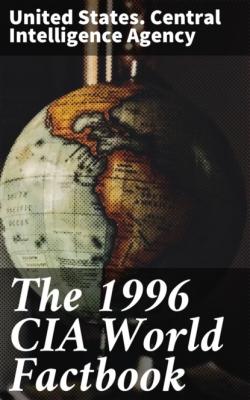The 1996 CIA World Factbook. United States. Central Intelligence Agency
Читать онлайн.| Название | The 1996 CIA World Factbook |
|---|---|
| Автор произведения | United States. Central Intelligence Agency |
| Жанр | Социология |
| Серия | |
| Издательство | Социология |
| Год выпуска | 0 |
| isbn | 4057664582324 |
Electricity: capacity: 4,900,000 kW production: 17 billion kWh consumption per capita: 2,200 kWh (1995 est.)
Agriculture: cotton, grain, rice, grapes, fruit, vegetables, tea, tobacco; cattle, pigs, sheep, goats
Illicit drugs: illicit cultivator of cannabis and opium poppy, mostly for CIS consumption; limited government eradication program; transshipment point for illicit drugs to Western Europe
Exports: $549.9 million (f.o.b., 1995)
commodities: oil and gas, chemicals, oilfield equipment, textiles,
cotton
partners: mostly CIS and European countries
Imports: $681.5 million (c.i.f., 1995)
commodities: machinery and parts, consumer durables, foodstuffs,
textiles
partners: European countries
External debt: $100 million (of which $75 million to Russia)
Economic aid:
recipient: ODA, $14 million (1993)
note: commitments, 1992–95, $1,000 million ($185 million in
disbursements); wheat from Turkey
Currency: 1 manat = 100 gopik
Exchange rates: manats per US$1 - 4,375 (April 1996), 4,500 (April 1995), 4,168 (end of December 1994)
Fiscal year: calendar year
Transportation———————
Railways:
total: 2,125 km in common carrier service; does not include
industrial lines
broad gauge: 2,125 km 1.520-m gauge (1,278 km electrified) (1993)
Highways:
total: 36,700 km
paved: 31,800 km (includes graveled)
unpaved: 4,900 km (1990 est.)
Pipelines: crude oil 1,130 km; petroleum products 630 km; natural
gas 1,240 km
Ports: Baku (Baki)
Airports:
total: 69
with paved runways over 3 047 m: 2
with paved runways 2 438 to 3 047 m: 6
with paved runways 1 524 to 2 437 m: 17
with paved runways 914 to 1 523 m: 3
with paved runways under 914 m: 1
with unpaved runways 914 to 1 523 m: 7
with unpaved runways under 914 m: 33 (1994 est.)
Communications———————
Telephones: 710,000 (1991 est.)
Telephone system: 202,000 persons waiting for telephone installations (January 1991 est.) domestic: telephone service is of poor quality and inadequate; a joint venture to establish a cellular telephone system in the Baku area was supposed to become operational in 1994 international: cable and microwave radio relay connections to former Soviet republics; connection through Moscow international gateway switch to other countries; satellite earth stations - 1 Intelsat and 1 Intersputnik (Intelsat provides service to Turkey and through Turkey to 200 more countries; Intersputnik provides direct service to New York)
Radio broadcast stations: AM NA, FM NA, shortwave NA (1 state-owned radio broadcast station)
Radios: NA
Television broadcast stations: 2 note: domestic and Russian TV programs are received locally and Turkish and Iranian TV is received from an Intelsat satellite through a receive-only earth station
Televisions: NA
Defense———
Branches: Army, Navy, Air Force, Maritime Border Guard
Manpower availability: males age 15–49: 1,952,390 males fit for military service: 1,574,813 males reach military age (18) annually: 68,006 (1996 est.)
Defense expenditures: 33.5 billion manats, NA% of GDP (1994); note - conversion of defense expenditures into US dollars using the current exchange rate could produce misleading results
======================================================================
@Bahrain———
Map—
Location: 26 00 N, 50 33 E—Middle East, archipelago in the
Persian Gulf, east of Saudi Arabia
Flag——
Description: red with a white serrated band (eight white points)
on the hoist side
Geography————
Location: Middle East, archipelago in the Persian Gulf, east of
Saudi Arabia
Geographic coordinates: 26 00 N, 50 33 E
Map references: Middle East
Area:
total area: 620 sq km
land area: 620 sq km
comparative area: 3.5 times the size of Washington, DC
Land boundaries: 0 km
Coastline: 161 km
Maritime claims:
contiguous zone: 24 nm
continental shelf: extending to boundaries to be determined
territorial sea: 12 nm
International disputes: territorial dispute with Qatar over the
Hawar Islands; maritime boundary with Qatar
Climate: arid; mild, pleasant winters; very hot, humid summers
Terrain: mostly low desert plain rising gently to low central
escarpment
lowest point: Persian Gulf 0 m
highest point: Jabal ad Dukhan 122 m
Natural resources: oil, associated and nonassociated natural gas,
fish
Land use:
arable land: 2%
permanent crops: 2%
meadows and pastures: 6%
forest and woodland: 0%
other: 90%
Irrigated land: 10 sq km (1989 est.)
Environment:
current issues: desertification resulting from the degradation of
limited arable land, periods of drought, and dust storms; coastal
degradation (damage to coastlines, coral reefs, and sea vegetation)
resulting from oil spills and other discharges from large tankers,
oil refineries, and distribution stations; no natural fresh water
resources so that groundwater and sea water are the only sources for
all water needs
natural hazards: periodic droughts; dust storms
international agreements: party to - Climate Change, Hazardous
Wastes, Law of the Sea, Ozone Layer Protection; signed, but not
ratified - Biodiversity
Geographic note: close to primary Middle Eastern petroleum sources; strategic location in Persian Gulf which much of Western world's petroleum must transit to reach open ocean
People———
